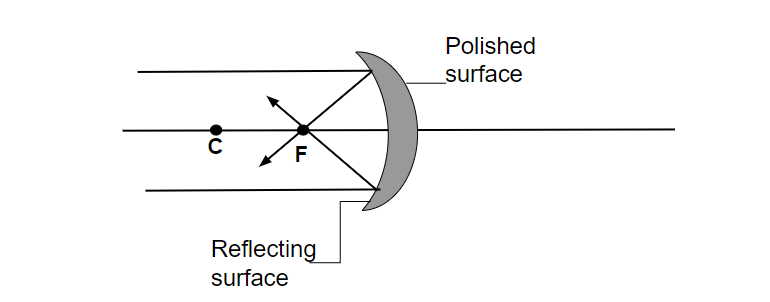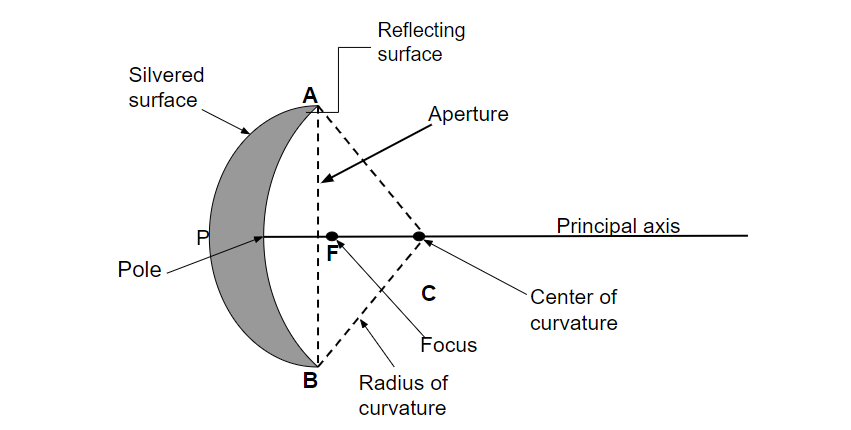球面镜的类型
您可能已经观察到,汽车后视镜中形成的图像较小,而后视镜中形成的图像大于物体的实际尺寸。牙医使用小镜子检查患者的牙齿。您可能还观察到,为了剃须目的,使用了不同的镜子。因此,不同的球面镜用于不同的目的。我们将在本章中讨论球面镜。
Spherical mirror is a type of mirror whose reflecting surfaces is the parts of a hollow sphere of glass.
球面镜的类型
根据反射面和反射的方向,它们有两种类型,即-
- 凹面镜和
- 凸面镜。
凹面镜
The type of spherical mirror in which reflection of light takes place from the side which is curved inward and the outer bulged surface is silvered polished is called a concave mirror. It is also called the converging mirror. It converges the parallel beam of light at focus(F). The shaving mirror and the mirror used by a dentist are examples of concave mirrors.

Concave mirror.
凹面镜的特性
- 平行于主轴的光线经过反射后会通过焦点。
- 通过主焦点 (F) 的光线变得平行于主轴。
- 穿过曲率中心的光线在反射后将采用相同的路径。
- 对于在极点 (P) 以任何角度入射的任何光线,反射光线都遵循反射定律(入射角 = 反射角)。
- 凹面镜成像的性质可以是真实的、虚拟的、正立的、倒置的。
- 图像的大小可以小于、大于或等于对象。
凹面镜的应用
- 剃须镜
- 手电筒灯
- 车头灯
- 牙科镜子
- 显微镜
- 望远镜
- 太阳能炉
凸面镜
The type of spherical mirror in which reflection of light takes place from the outer bulged surface and curved inward surface is silvered polished. It is also called the diverging mirror. The side view mirror of vehicle and magnifying are the example of convex mirror.

Convex mirror
凸面镜的特性
- 平行于主轴的光线经过反射后会通过焦点。
- 通过主焦点 (F) 的光线变得平行于主轴。
- 穿过曲率中心的光线在反射后将采用相同的路径。
- 对于在极点 (P) 以任何角度入射的任何光线,反射光线都遵循反射定律(入射角 = 反射角)。
- 凸面镜所形成的像的性质是虚的和正的。
- 图像的大小将小于对象。
凸面镜的应用
- 它用于大型工作场所,让人们环顾四周(如医院)。
- 它用于汽车的后视镜。
- 它用于 ATM 中,允许用户查看是否有人站在他们身后。
- 它用于望远镜。
- 它也用于太阳镜以反射阳光。
球面镜中使用的术语
- 极点:球面镜的中点P称为极点。
- 曲率中心:形成球面镜的球心“c”称为曲率中心。
- 曲率半径:形成球面镜的球面半径称为曲率半径。 (R= AC 或 BC)
- 主轴:线通过极点,镜面的曲率中心称为主轴。下图中的线 PC 为主轴。
- 主焦点:当平行于主轴的窄光束从球面镜反射后从点 F 会聚或看起来会聚时称为主焦点。
- 焦距:它是焦点和镜极之间的距离(f=PF)。
- 线性孔径:球面镜圆形边界的直径AB称为线性孔径。

球面镜标志约定

- 所有入射光从左向右传播
- 所有的距离都是从镜子的极点开始测量的。
- 在入射光方向(镜子的右轴)上测量的所有距离都取为正
- 在入射光的相反方向(镜子的 LHS)上测量的所有距离都被视为Negative 。
- 高度是垂直于主轴测量的。
- 向上到主轴的高度测量为正。
- 向下测量到主轴的高度被视为负值。
示例问题
问题一:车辆前照灯使用哪种镜子,为什么?
回答:
Concave mirror is used in the headlight of the vehicle because when bulb of the car is placed at the focus of concave mirror, it allows the light to spread at longer distance.
问题2:凹面镜放在水下。镜子的焦距会发生什么变化?
回答:
As focal length of the spherical mirror does not depend upon the medium. So, there will be no change in the focal length of concave mirror.
问题3:为什么剃须时凹面镜优于平面镜?
回答:
Concave mirror is preferred because it forms a magnified and erect image, when the face is kept closer to the mirror.
问题4:车辆后视镜使用哪种镜子,为什么?
回答:
Convex mirror is used in the rear-view mirror of the car because the image formed by the convex mirror is diminished and erect, thus it provides the larger field of view.
问题5:你如何在不接触表面的情况下区分平面镜、凹面镜和凸面镜?
回答:
- Magnification is 1, means plane mirror
- Magnification is >1, means concave mirror
- Magnification is <1, means convex mirror
问题 6:拉胡尔站在球面镜前。他发现他的图像有一个非常小的头。告诉我们镜子的形状是什么?
回答:
As the image of the head is very small means mirror was convex in shape.
问题7:为什么用抛物面凹面镜作为望远镜的物镜?
回答:
Parabolic concave mirror is used because it is free from spherical and chromatic aberrations.